Versatile Tile

Design trend offers classic look, slip resistance
A home design trend popular more than a century ago is making a comeback in a big way.
 Earning its name from the small bronze-hued currency, penny tile first gained popularity in the early 1900s for use in kitchens and bathrooms. This timeless option has become a smash hit once again with today’s builders and homeowners.
Earning its name from the small bronze-hued currency, penny tile first gained popularity in the early 1900s for use in kitchens and bathrooms. This timeless option has become a smash hit once again with today’s builders and homeowners.
“One of the main reasons is its classic look,” said 318 Tile owner and installer River Smith. “Another reason is its slip resistance. A lot of customers want accessible showers or curbless showers and they’re worried about slipping on the floors.” Penny tiles are ideal for high traffic or wet areas.
Traditionally, penny tiles were made of porcelain and unglazed – the lack of a finish lent itself to slip resistance.
A fun fact about these tiles is that they only came in white in the early 1900s. Smith says that’s because homeowners were worried about cleanliness and believed white held fewer germs. Remember, this is the timeframe when indoor bathrooms were becoming common. “People were a little leery about that and thought it was strange,” said Smith. “They thought white tile stayed cleaner. That’s why you see white subway tile and white penny rounds in bathrooms. Porcelain is fired at a higher temperature, so it absorbs less water and fewer germs.”
Smith says, eventually, high-end homes and commercial buildings began to add patterns to the field tile. It was also common for a storefront to display its name in penny rounds or hexagon tiles.
Smith, a certified tile installer in Louisiana, is also a mosaicist and specializes in mosaic tile installation. “There are hundreds of different patterns. It’s based on simple geometry,” he said. “That’s what works so well with the penny rounds – the many different designs that you can get out of the product.”
The versatile tile comes in an array of colors and materials like glass, ceramic, stone, metal, porcelain and even cork. They range in size from ¾ inch to one inch. Flowers, starbursts, pinwheel, nautilus shells and diamonds are among the patterns created with these smallbut-mighty tiles. Smith says grout colors are also available in every hue imaginable and can even be glow-inthe-dark. He says the grout selected can either enhance each tile and make them pop or make them all flow together and mute some of the pattern.
“If you’ve ever been in a house that was built in the 1950s here in Shreveport, or anywhere in the country, and you see penny rounds or hexagon tiles – it’s a solid installation,” said Smith. “A lot of times, there are no cracks, and it looks as good as it did the day it was installed.” Penny rounds are also a great option to match an older home’s style or to replace tile that may be damaged or missing.
“Hexagon, penny rounds and subway tile are very popular. You can’t go wrong with it,” said Smith. “It’s going to look good today, and it looked good 100 years ago.”
